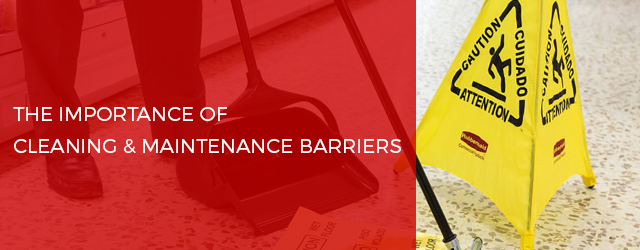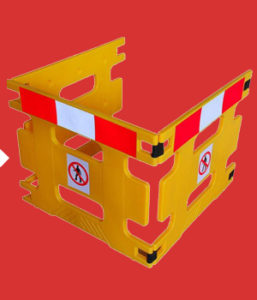
Cleaning signage and maintenance barriers are a part of our everyday life. From a young age they become very recognisable signs. The barriers come in many guises. I bet that you will have seen them all; from the traditional A-Frame sign, to large yellow maintenance barriers and door way signs. The next time you go to the shopping centre or supermarket look around you, and you are bound to see some in use.
It’s their frequency of use that can sometimes mean they are taken for granted or ignored. The signs can go into our sub-conscious, therefore we don’t pay as much attention to them but will have noticed them without knowing. But the importance of a cleaning sign or maintenance barrier should never be underestimated.
In this blog post we’re going to look at the importance of these signs, particularly in relation to your business. As well as the facts and statistics of slips and falls as the result of wet or damp floors and the cost of this to industry.
Why is it important to use wet floor signs?
A wet floor sign is critical as it is used to warn people that there is the possibility that the floor they are walking on is wet and slippery. The sign’s purpose is to prevent people from falling and slipping over.
Wet floor signs can often lose their effectiveness if misused. Once the area has been cleaned and is safe for pedestrian footfall, then wet floor signs should be removed immediately. When this is not done people often ignore them which potentially puts them at risk the next time.
Why should you invest in vital cleaning signage for avoidable hazards?
Wet floors are the highest contributor to slips and falls and are a costly legal liability. In the EU slips, trips and falls occur every 3 minutes. In this day and age, a slight injury from slipping on a wet floor can result in a law suit and a hefty pay-out. The cost to industry during in a year can exceed £500 million. However, this figure doesn’t include the incalculable cost to human well-being and recovery from accidents.
Recent figures show that slips represent 33% of all reported injuries, of which 50% incidents involve members of the public.
Don’t think that this won’t happen to you and your business. Wet floors are an avoidable hazard. With some very inexpensive cleaning and maintenance signage and an effective cleaning schedule you can prevent accidents from happening. This isn’t to say that they won’t ever happen – but at least you and your business can have peace of mind that you did all you could to protect people.
HSE Guidance
HSE recommends that businesses ensure “cleaning happens at the right time and is carried out in the correct manner”. They reinforce that wet floor signs should always be used. Therefore, when possible, it is highly recommended that you arrange for the cleaning to be done outside of hours, in quieter times when there are not so many pedestrians around. In schools, offices and some shops this is easier to organise.
However, if cleaning can’t be avoided when there’s people present, here are a few tips for positioning your cleaning signs and maintenance barriers.
- Make sure you position the cone or barrier so that it alerts the person before they walk onto the wet area. It’s often too late if the cone is on the wet area or after it.
- Walkers approaching from all directions? A four sided sign will cover this, meaning you can economise on the amount of signage you require.
- For larger workplaces or public spaces think of investing in multi-lingual signs. Most of our wet floor signs do also have the universally recognisable graphic of a man slipping over.
Products we recommend
Rubbermaid Two Sided Caution Wet Floor Sign
- Ideal for narrow areas and smaller spaces
- Available with multilingual caution message
- International wet floor system standard
- Easily folds for convenient storage

- 2 and 3 Panel maintenance barriers with reflective stripes
- Multi-linking panels allow for custom shapes and sizes
- Suitable for indoor and outdoor use
- Panels fold away for easy storage when not required
- Complies to BS 7801:1995 Safe Working on Elevators and Passenger Conveyors in use
- Available with ‘Caution’ or reflective red ‘No Entry’ sign
Rubbermaid Pop-up Safety Cones
- Company storage and quick deployment
- Can be fixed to walls or aisles in supermarkets
- Ideal for spillages rather than cleaning schedules
Overall the aim of this blog post is to raise awareness of the need for cleaning and maintenance barriers to help combat slips and falls. If you need further guidance in creating an effective cleaning program or would like more information and case studies please refer to HSE guidance available here.